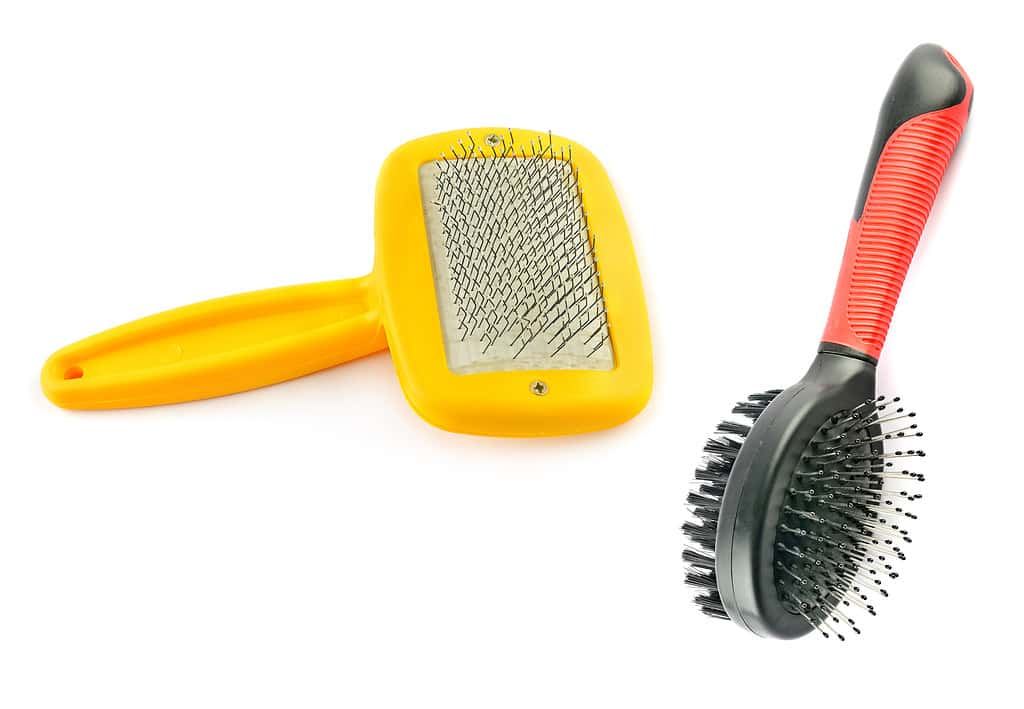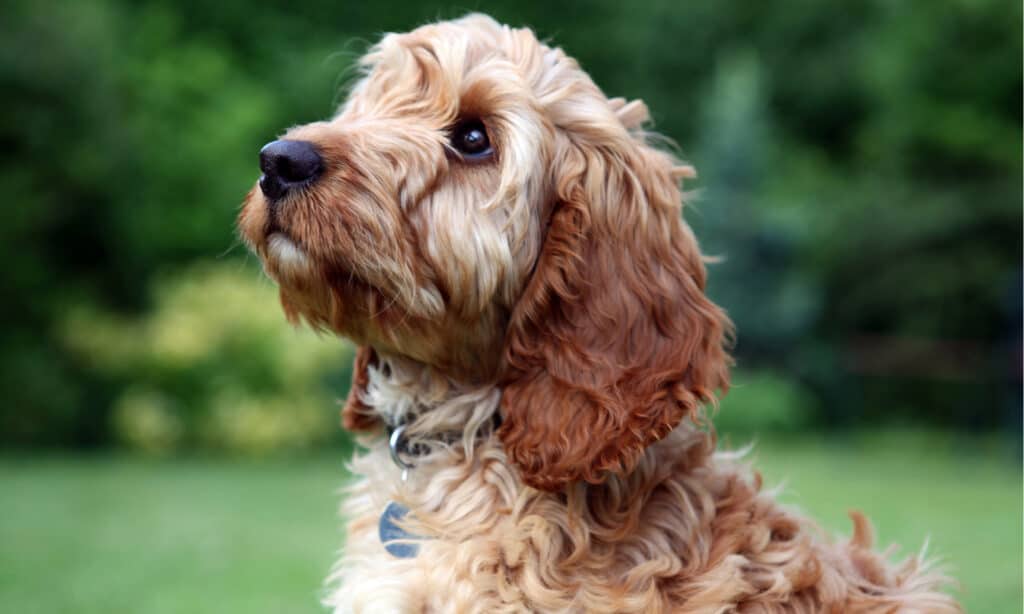Even though Cockapoos don’t shed, they still molt twice per year. They can easily get matted if you’re not properly maintaining their fur. Did you know that their coats change? From anywhere between six to 12 months up until 18 months of age, you can expect their coats to change in texture and appearance completely! This can create quite a shift in how you manage their grooming. This guide will help you keep your Cockapoo’s coat in perfect condition.
1. Brush Them at Least 4 to 5 Times per Week

Gentle pressure is essential when using slicker brushes.
©AlinaMD/iStock via Getty Images
Brushing your dog will stimulate their skin, which, in turn, will increase oil production and remove dead skin. Pin brushes, slickers, and wide-tooth combs will come in handy here. Line brushing is a technique used for dogs with a double coat by working in sections. You won’t just rish a brush over the top of your Cockapoo’s coat. Beginning with a comb is crucial to get to the undercoat and loosen up dirt and debris. Many owners choose to do this while bathing their dogs and working conditioner into their coats.
Don’t brush your Cockapoo when they’re wet unless they have conditioner in their coat first. Otherwise, you’re sure to get snarls and tangles. When brushing, pay close attention to spots that can become easily matted. This includes their ears, beards, armpits, and tails. Your brushing sessions should be about ten minutes long, and aim to do this about 4 or 5 times per week.
2. Bathing and Drying Techniques
Did you know that you can bathe your dogs too much? Some pet owners go overboard and wash their dogs once per week. Even if your dog gets muddy, you shouldn’t thoroughly bathe them every week. You can damage their fur and irritate their skin by overwashing them. Spot washing and quick rinses are the key to keeping them clean between washes. Instead, it would be best to bathe your Cockapoo every six weeks. Use a well-rounded shampoo and conditioner that’s gentle on their skin.
Don’t use cotton buds to clean your dog’s ears! The depth of a dog’s ear can be deceiving, and you might end up shoving the cotton ball too far into their ear canal, getting it stuck, and requiring a visit to the vet. Also, Don’t let your Cockapoo air dry! You’ll surely see tangles and mats if you don’t take the time to towel dry and blow dry them. Microfiber towels are a good option for their coats because they won’t trap and tangle fur while drying them.
3. What Is the Best Haircut for a Cockapoo?
Tight, curly hair isn’t optimal when it comes to long coat lengths. It’s a good idea to bring them into your groomer about once per month. An adult Cockapoo’s coat can grow to around 15 cm in length, but it’s not recommended to let it grow that long unless you’re confident you can maintain it.
There are three common haircuts you will find when it comes to Cockapoos:
- Teddy Bear
- Lamb
- Summer Cut
The teddy bear cut is a popular choice for many curly-coated breeds. The head is rounded and fluffy. Their coat is the same length all over the body as well. Usually, the length of the coat will be 0.5–2 inches long. The lamb cut is similar to the bear, but the length of the legs is left longer than the rest of the coat. Summer cuts are very straightforward. Their coats will be shaved down as close to the skin as possible to keep your dog cool during warmer months. Giving your dogs a trim at home between grooming visits can also be highly beneficial.
4. How Else Can You Get Your Cockapoo a Healthy Coat?

Cockapoos can have either hair or fur, depending on if they lean more like Cocker Spaniel or Poodle.
©Lee Ph/Shutterstock.com
Nutrition is the first and foremost way to get a healthy coat for your Cockapoo. Their hair is mainly made up of protein, so poor protein intake can harm their coats. Protein should always be the primary ingredient on your dog’s foot label. Their coat is a good indication of their overall health, as deficiencies and other issues will show in their coats.
Choosing high-tier foods will benefit your pup the most in the end. Make sure the treats you give them are healthy, too! The next thing to be aware of is their omega fatty acid intake. Omega-3 and Omega-6 fatty acids stimulate hair growth, support their joints, and can aid in skin allergies. Some owners also swear by taking coconut oil and massaging it into their coats! This can add shine and nourish dry or dehydrated skin.
The photo featured at the top of this post is © Emma Slade/Shutterstock.com
Ready to discover the top 10 cutest dog breeds in the entire world?
How about the fastest dogs, the largest dogs and those that are -- quite frankly -- just the kindest dogs on the planet? Each day, AZ Animals sends out lists just like this to our thousands of email subscribers. And the best part? It's FREE. Join today by entering your email below.
Thank you for reading! Have some feedback for us? Contact the AZ Animals editorial team.







